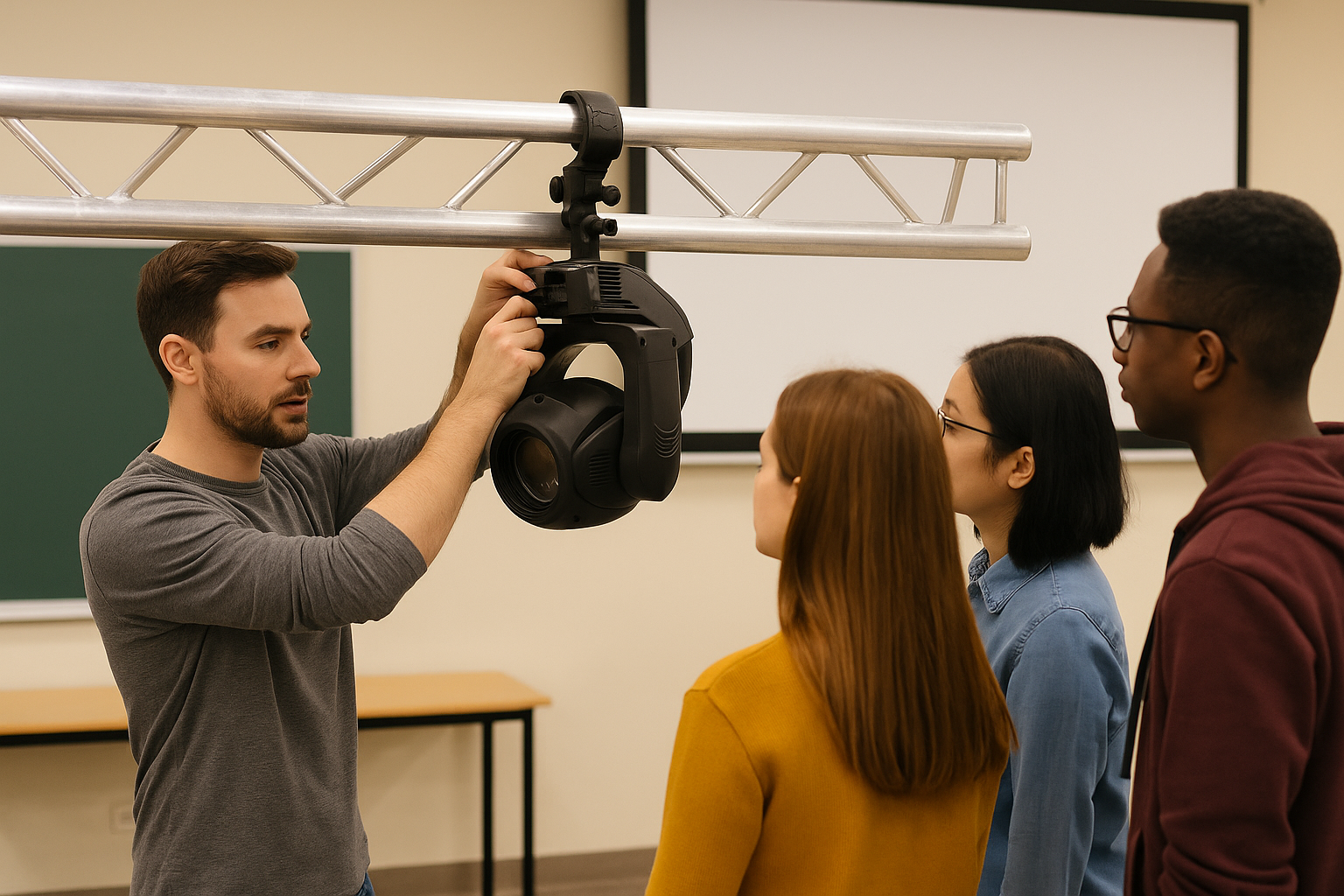When introducing newcomers to the world of lighting design and operation, it’s easy to get caught up in creative expression and fixture control. But one of the most critical areas often overlooked—especially in small productions, volunteer-run venues, and school settings—is safety.
Lighting systems carry both electrical and physical risks. Proper education can prevent injuries, equipment damage, and show interruptions. Whether you’re leading a university course, training interns, or guiding volunteers, prioritizing risk awareness and best practices is essential for a safe working environment.
Why Lighting Safety Matters
Lighting technicians work with equipment that:
Requires high-voltage power connections
Involves elevated rigging and positioning
Emits intense heat or blinding light
Operates in dark or noisy environments
For beginners, these hazards aren’t always obvious. Mistakes like daisy-chaining power cables improperly or adjusting a fixture without securing its yoke can lead to serious consequences.
Common Risks Include:
Electric shocks from improperly grounded equipment
Overloaded circuits or overheating extension cords
Trip hazards from poorly managed cabling
Burns from hot metal housings
Falling fixtures due to incorrect mounting
Eye strain or damage from looking into intense beams
Building a Safety-First Mindset
Effective training starts with instilling a culture of constant awareness. Here’s how to teach beginners to treat lighting setups with the seriousness they require:
1. Start with Safety Briefings
Before touching a light or cable, provide an overview of:
The venue’s emergency exit plan
Electrical safety zones (e.g., where not to stand or reach)
Load capacities for circuits or dimmers
Required protective gear (gloves, eye protection, etc.)
Make this a standard protocol at the beginning of every session or setup day.
2. Teach Cable Discipline
Loose, tangled, or poorly taped cables are one of the most common causes of accidents. Train learners to:
Always coil cables properly
Never plug or unplug under load
Use gaffer tape and ramps to secure paths
Color-code or label cables to reduce confusion
Practical Safety Modules for Beginners
Here’s a structured framework you can follow to teach safety effectively:
| Module | Focus Area | Key Learning Points |
|---|---|---|
| 1 | Electrical Basics | Voltage/amperage awareness, grounding, surge protection |
| 2 | Cable Management | Routing, taping, safety zones, color-coding |
| 3 | Fixture Handling | Safe lifting, bracket adjustment, tightening mechanisms |
| 4 | Ladder and Truss Safety | Proper footwear, two-person rigging, locking mechanisms |
| 5 | Emergency Protocols | What to do in case of electrical failure or fire |
| 6 | Eye and Skin Protection | UV output awareness, use of shields or gels |

Integrating Safety into Hands-On Work
Hands-on experience is where many learners develop bad habits. Reinforce safety protocols every time a practical task is introduced.
For example:
When demonstrating how to mount a moving head fixture, don’t just talk through the DMX setup. Also show:
How to secure safety cables
How to test truss stability before climbing
How to check connectors for corrosion or looseness
Role-Playing Accident Scenarios
One engaging way to teach awareness is to simulate “what if” accidents. Have trainees:
Identify all violations in a purposefully “unsafe” mock setup
Respond to hypothetical electrical fire or tripping incidents
Practice safe evacuation and shutoff procedures
This prepares them not just to avoid accidents—but to respond if something does go wrong.
Mental and Visual Checklists
Encourage students to develop habits like:
Doing a visual inspection of cables and connectors before powering on
Double-checking mounting bolts and safety lines
Keeping clear mental checklists for pre-show setup and teardown
Even providing printed checklists as part of beginner kits can reduce risk and help form strong habits.
Documentation and Signage
Ensure all participants understand where to find:
Circuit load charts
Breaker panel maps
Warning signage for high-current areas
Instruction manuals or safety datasheets for fixtures
Clear documentation and signage reduce the chances of confusion and ensure everyone is working from the same knowledge base.
Promoting a Culture of Speaking Up
Beginners often assume their question might be “stupid,” and avoid reporting unsafe behavior. Emphasize:
“If it feels wrong, stop and ask.”
Make it a rule that anyone on the crew can halt a setup if they feel something is unsafe. This shifts responsibility from one supervisor to the entire group.
Conclusion
Teaching lighting safety is not a one-time seminar—it’s a continuing mindset. The sooner beginners learn to respect the technical and physical power of stage lighting, the more confident and competent they become.
Ultimately, the best show isn’t just about dazzling effects—it’s about keeping every hand, every eye, and every life protected behind the scenes.
READ MORE:





Blue Sea Lighting is an enterprise with rich experience in the integration of industry and trade in stage lighting and stage special effects related equipment. Its products include moving head lights, par lights, wall washer lights, logo gobo projector lights, power distributor, stage effects such as electronic fireworks machines, snow machines, smoke bubble machines, and related accessories such as light clamps.
Quick Links
For more questions subscribe to our email








